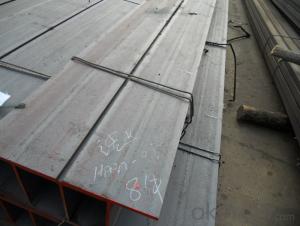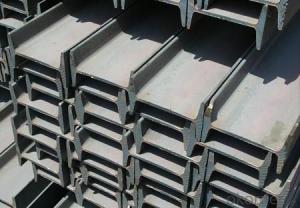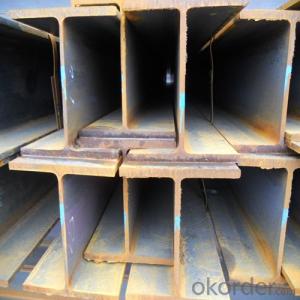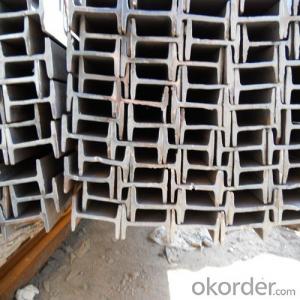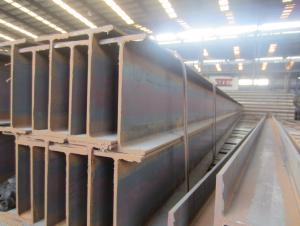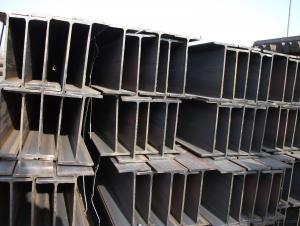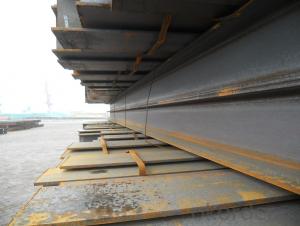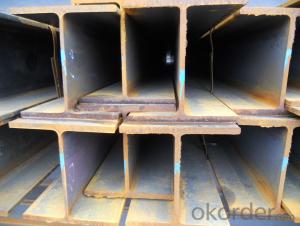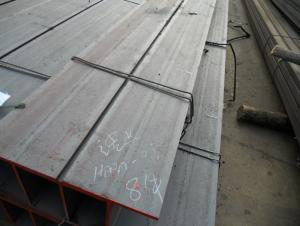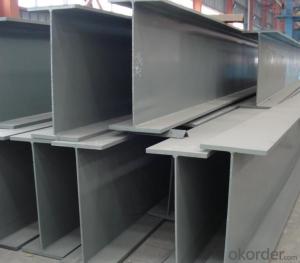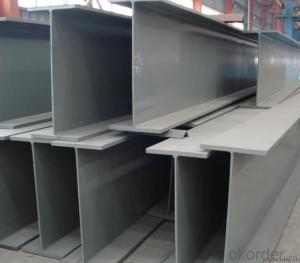Hot Rolled Steel H-Beam GB/JIS/ASTM/DIN High Qulity
- Loading Port:
- Tianjin
- Payment Terms:
- TT OR LC
- Min Order Qty:
- 500 m.t.
- Supply Capability:
- 50000 m.t./month
OKorder Service Pledge
OKorder Financial Service
You Might Also Like
Specification
Product Description:
OKorder is offering Hot Rolled Steel H-Beam GB/JIS/ASTM/DIN High Qulity at great prices with worldwide shipping. Our supplier is a world-class manufacturer of steel, with our products utilized the world over. OKorder annually supplies products to European, North American and Asian markets. We provide quotations within 24 hours of receiving an inquiry and guarantee competitive prices.
Product Applications:
Hot Rolled Steel H-Beam GB/JIS/ASTM/DIN High Qulity are ideal for structural applications and are widely used in the construction of buildings and bridges, and the manufacturing, petrochemical, and transportation industries.
Product Advantages:
OKorder's Hot Rolled Steel H-Beam GB/JIS/ASTM/DIN High Qulity are durable, strong, and resist corrosion.
Main Product Features:
· Premium quality
· Prompt delivery & seaworthy packing (30 days after receiving deposit)
· Corrosion resistance
· Can be recycled and reused
· Mill test certification
· Professional Service
· Competitive pricing
Product Specifications:
H x B
(mm)
| T1 | T2 | JIS Weight
(kg/m)
| GB Weight
(kg/m)
|
100*100 | 6 | 8 | 16.9 | 17.2 |
125*125 | 6.5 | 9 | 23.6 | 23.8 |
150*75 | 5 | 7 | 14 | 14.3 |
148*100 | 6 | 9 | 20.7 | 21.4 |
150*150 | 7 | 10 | 31.1 | 31.9 |
175*90 | 5 | 8 | 18 | 18.2 |
175*175 | 7.5 | 11 | 40.4 | 40.4 |
198*99 | 4.5 | 7 | 17.8 | 18.5 |
200*100 | 5.5 | 8 | 20.9 | 21.7 |
194*150 | 6 | 9 | 29.9 | 31.2 |
200*200 | 8 | 12 | 49.9 | 50.5 |
248*124 | 5 | 8 | 25.1 | 25.8 |
250*125 | 6 | 9 | 29 | 29.7 |
244*175 | 7 | 11 | 43.6 | 44.1 |
250*250 | 9 | 14 | 71.8 | 72.4 |
298*149 | 5.5 | 8 | 32 | 32.6 |
298*201 | 9 | 14 | 65.4 | |
300*150 | 6.5 | 9 | 36.7 | 37.3 |
294*200 | 8 | 12 | 55.8 | 57.3 |
300*300 | 10 | 15 | 93 | 94.5 |
346*174 | 6 | 9 | 41.2 | 41.8 |
350*175 | 7 | 11 | 49.4 | 50 |
340*250 | 9 | 14 | 78.1 | 79.7 |
350*350 | 12 | 19 | 135 | 137 |
400*200 | 8 | 13 | 65.4 | 66 |
390*300 | 10 | 16 | 105 | 107 |
400*400 | 13 | 21 | 172 | 172 |
446*199 | 8 | 12 | 65.1 | 66.7 |
450*200 | 9 | 14 | 77.9 | 79.5 |
440*300 | 11 | 18 | 121 | 124 |
496*199 | 9 | 14 | 77.9 | 79.5 |
500*200 | 10 | 16 | 88.2 | 89.6 |
488*300 | 11 | 18 | 125 | 129 |
596*199 | 10 | 15 | 92.5 | 95.1 |
600*200 | 11 | 17 | 103.4 | 106 |
588*300 | 12 | 20 | 147 | 151 |
700*300 | 13 | 24 | 182 | 185 |
800*300 | 14 | 26 | 207 | 210 |
900*300 | 16 | 28 | 240.1 | 243 |
Usage & Applications of Hot Rolled Steel H-beam For Sale
Commercial building structure ;Pre-engineered buildings; Machinery support structure; Prefabricated structure; Medium scale bridges; Ship-building structure.etc.
Production flow of Hot Rolled Steel H-beam For Sale
Material prepare (billet) —heat up—rough rolling—precision rolling—cooling—packing—storage and transportation
*If you would like to get our price, please inform us the size, standard/material and quantity. Thank you very much for your attention.
FAQ:
Q1: Why buy Materials & Equipment from OKorder.com?
A1: All products offered byOKorder.com are carefully selected from China's most reliable manufacturing enterprises. Through its ISO certifications, OKorder.com adheres to the highest standards and a commitment to supply chain safety and customer satisfaction.
Q2: How do we guarantee the quality of our products?
A2: We have established an advanced quality management system which conducts strict quality tests at every step, from raw materials to the final product. At the same time, we provide extensive follow-up service assurances as required.
Q3: How soon can we receive the product after purchase?
A3: Within three days of placing an order, we will begin production. The specific shipping date is dependent upon international and government factors, but is typically 7 to 10 workdays.
Q4: What makes stainless steel stainless?
A4: Stainless steel must contain at least 10.5 % chromium. It is this element that reacts with the oxygen in the air to form a complex chrome-oxide surface layer that is invisible but strong enough to prevent further oxygen from "staining" (rusting) the surface. Higher levels of chromium and the addition of other alloying elements such as nickel and molybdenum enhance this surface layer and improve the corrosion resistance of the stainless material.
Q5: Can stainless steel rust?
A5: Stainless does not "rust" as you think of regular steel rusting with a red oxide on the surface that flakes off. If you see red rust it is probably due to some iron particles that have contaminated the surface of the stainless steel and it is these iron particles that are rusting. Look at the source of the rusting and see if you can remove it from the surface.
Images:

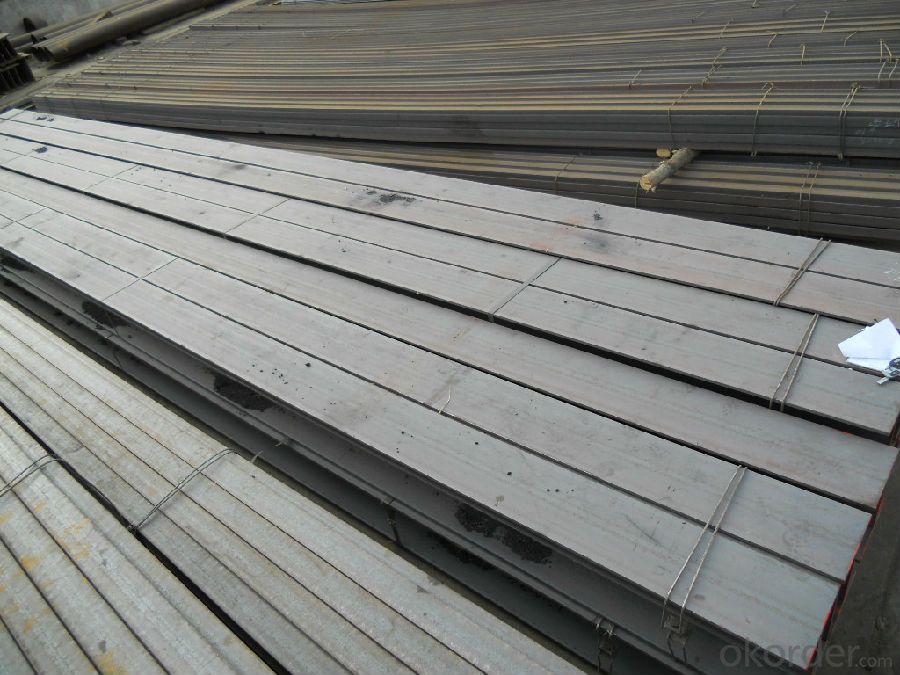

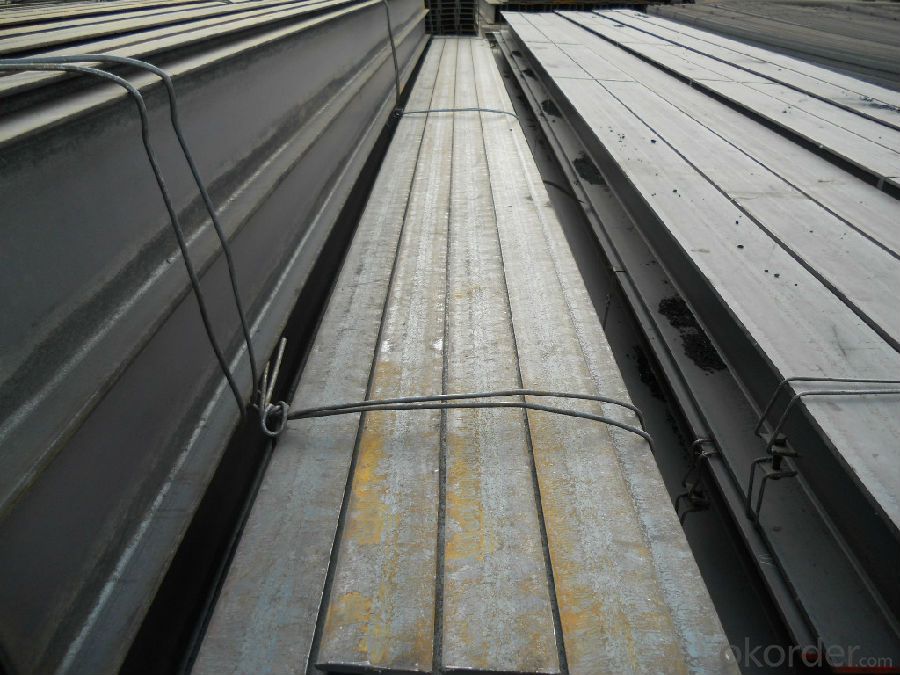
- Q: How are Steel H-Beams installed on-site?
- Steel H-Beams are typically installed on-site through a process involving hoisting and aligning. First, a crane or heavy-duty lifting equipment is used to lift the H-Beams into position. The beams are then aligned according to the required specifications, ensuring that they are level and properly oriented. Once in position, the beams are secured using various methods such as welding, bolting, or using specialized connectors. The installation process requires skilled workers and adherence to safety protocols to ensure a secure and stable structure.
- Q: What are the different grades of steel used in manufacturing H-beams?
- In the manufacturing of H-beams, various grades of steel are commonly utilized. These grades are categorized based on their mechanical properties and chemical composition. One frequently employed grade is ASTM A36, which is characterized by its low carbon content. This grade exhibits commendable strength and ductility, rendering it suitable for a diverse range of applications. Another commonly employed grade is ASTM A572, a high-strength, low alloy steel. It boasts an excellent strength-to-weight ratio and finds extensive use in heavy construction projects. Additional grades that are frequently utilized include ASTM A992, a structural steel with enhanced corrosion resistance, and ASTM A588, a high-strength, low alloy steel with improved atmospheric corrosion resistance. The selection of the appropriate grade hinges upon the specific requirements of the H-beam, encompassing desired strength, durability, and resistance to corrosion. Factors such as load-bearing capacity, environmental conditions, and intended use of the H-beam also play a role in determining the suitable grade of steel. To ascertain the most suitable grade of steel for manufacturing H-beams in a particular application, it is crucial to consult relevant industry standards and specifications, as well as leverage the expertise of engineers and manufacturers.
- Q: Can steel H-beams be used for industrial buildings?
- Industrial buildings can indeed utilize steel H-beams. I-beams, also referred to as steel H-beams, are widely employed in the construction industry due to their exceptional structural properties. These beams are specifically engineered to withstand immense loads and offer support for expansive spans, rendering them ideal for industrial buildings that necessitate a robust and long-lasting framework. Steel H-beams possess a remarkable strength-to-weight ratio, enabling them to bear the weight of heavy machinery and equipment without compromising the building's structural integrity. Moreover, their versatility allows for various architectural designs and the flexibility to accommodate diverse building layouts. All in all, steel H-beams are highly favored in the construction of industrial buildings, owing to their strength, durability, and structural efficacy.
- Q: Can steel H-beams be used in museum or art gallery construction?
- Yes, steel H-beams can be used in museum or art gallery construction. They are a common choice for structural support due to their strength, durability, and ability to support heavy loads. Steel H-beams can provide the necessary stability and structural integrity required for large open spaces, allowing for flexible and creative design possibilities in museum or art gallery construction.
- Q: What are the different welding methods for steel H-beams?
- There are several different welding methods that can be used for steel H-beams, including shielded metal arc welding (SMAW), gas metal arc welding (GMAW), flux-cored arc welding (FCAW), and submerged arc welding (SAW). Each method has its own advantages and considerations, such as the cost, speed, and quality of the weld. The specific method used will depend on factors such as the thickness of the steel, the desired strength of the weld, and the available equipment and resources.
- Q: How do steel H-beams compare to I-beams in terms of strength?
- Steel H-beams are generally stronger than I-beams due to their wider flange and greater cross-sectional area, which allows them to withstand higher loads and provide better structural support.
- Q: What is a steel H-beam?
- A steel H-beam, which is also referred to as H-section or I-section, is a type of structural beam that is made out of steel and has a shape that resembles the letter "H". This beam is extensively utilized in construction and civil engineering projects because of its remarkable strength and versatility. The primary purpose of the H-beam is to evenly distribute the weight or load across its horizontal flanges, which are connected by a vertical web. This particular design offers exceptional load-bearing capabilities and enables structures to have longer spans and enhanced stability. H-beams are commonly employed in buildings, bridges, highways, and other infrastructure projects to provide support for heavy loads and resist bending or twisting forces. The manufacturing process of the steel H-beam involves either hot rolling or welding, and it can be obtained in various sizes and dimensions to suit different applications.
- Q: Can steel H-beams be cut or modified on-site?
- Yes, steel H-beams can be cut or modified on-site. H-beams are commonly used in construction projects and can be customized to fit specific measurements and requirements. On-site modification of H-beams may involve cutting the beams to a desired length, drilling holes for fasteners, or welding additional pieces to create connections or supports. However, it is important to note that proper safety precautions and equipment should be used when cutting or modifying steel beams on-site.
- Q: What are the design considerations for steel H-beams in high-rise buildings?
- When it comes to designing steel H-beams for high-rise buildings, it is crucial to take several important factors into consideration. These factors include: 1. Load-bearing capacity: The primary purpose of steel H-beams is to bear and transfer the weight of the building. Therefore, the design must guarantee that the beams have enough load-bearing capacity to support the structure's weight. This involves considering the dead load (building's weight), live load (occupant and equipment loads), and wind load. 2. Structural stability: High-rise buildings are exposed to various forces, such as wind, seismic activity, and temperature fluctuations. Consequently, the design of H-beams must ensure the building's structural stability by incorporating adequate bracing and connections that can withstand these forces and prevent any potential collapses. 3. Fire resistance: In the event of a fire, it is essential for steel H-beams to maintain their structural integrity for a specified period, allowing occupants to evacuate safely. To enhance the beams' fire resistance, fire-resistant coatings or fireproofing materials can be applied. 4. Deflection and vibration control: High-rise buildings are susceptible to deflection and vibrations caused by wind, earthquakes, and dynamic loads. The design must consider the maximum allowable deflection and vibration limits to ensure the comfort and safety of occupants. Measures such as increasing beam depth, adding stiffeners, or incorporating dampening devices can be implemented to control deflection and vibration. 5. Fabrication and construction considerations: The design of steel H-beams should also take into account ease of fabrication and construction. This involves designing the beams with standard sizes and lengths to facilitate efficient fabrication and erection processes. Moreover, the connections between beams should be designed to ensure ease of installation while maintaining structural integrity. 6. Sustainability: In modern high-rise buildings, it is crucial to incorporate sustainable design principles. Therefore, the design of steel H-beams should aim to minimize material consumption and waste, optimize energy efficiency, and maximize the use of recycled materials. All in all, the design considerations for steel H-beams in high-rise buildings encompass ensuring load-bearing capacity, structural stability, fire resistance, deflection and vibration control, ease of fabrication and construction, and sustainability. By meticulously addressing these considerations, engineers can create high-rise buildings that are both safe and efficient, while also being sustainable.
- Q: Are steel H-beams suitable for use in the construction of sports stadiums or arenas?
- Yes, steel H-beams are commonly used in the construction of sports stadiums and arenas due to their structural strength, versatility, and ability to support large loads.
Send your message to us
Hot Rolled Steel H-Beam GB/JIS/ASTM/DIN High Qulity
- Loading Port:
- Tianjin
- Payment Terms:
- TT OR LC
- Min Order Qty:
- 500 m.t.
- Supply Capability:
- 50000 m.t./month
OKorder Service Pledge
OKorder Financial Service
Similar products
Hot products
Hot Searches
Related keywords
